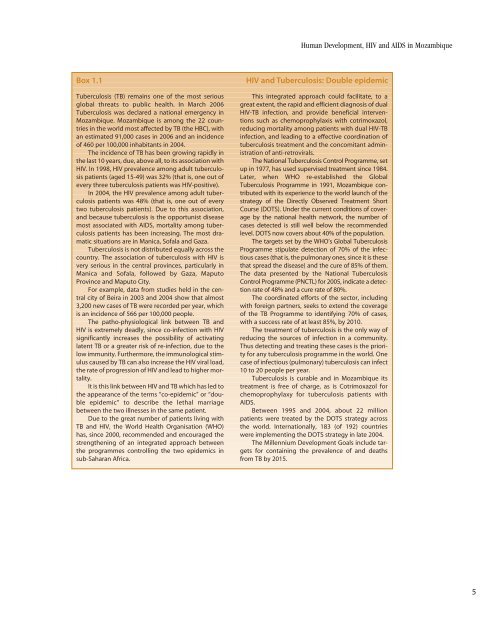English language version - Human Development Reports - United ...
English language version - Human Development Reports - United ...
English language version - Human Development Reports - United ...
- No tags were found...
You also want an ePaper? Increase the reach of your titles
YUMPU automatically turns print PDFs into web optimized ePapers that Google loves.
<strong>Human</strong> <strong>Development</strong>, HIV and AIDS in MozambiqueBox 1.1Tuberculosis (TB) remains one of the most seriousglobal threats to public health. In March 2006Tuberculosis was declared a national emergency inMozambique. Mozambique is among the 22 countriesin the world most affected by TB (the HBC), withan estimated 91,000 cases in 2006 and an incidenceof 460 per 100,000 inhabitants in 2004.The incidence of TB has been growing rapidly inthe last 10 years, due, above all, to its association withHIV. In 1998, HIV prevalence among adult tuberculosispatients (aged 15-49) was 32% (that is, one out ofevery three tuberculosis patients was HIV-positive).In 2004, the HIV prevalence among adult tuberculosispatients was 48% (that is, one out of everytwo tuberculosis patients). Due to this association,and because tuberculosis is the opportunist diseasemost associated with AIDS, mortality among tuberculosispatients has been increasing. The most dramaticsituations are in Manica, Sofala and Gaza.Tuberculosis is not distributed equally across thecountry. The association of tuberculosis with HIV isvery serious in the central provinces, particularly inManica and Sofala, followed by Gaza, MaputoProvince and Maputo City.For example, data from studies held in the centralcity of Beira in 2003 and 2004 show that almost3,200 new cases of TB were recorded per year, whichis an incidence of 566 per 100,000 people.The patho-physiological link between TB andHIV is extremely deadly, since co-infection with HIVsignificantly increases the possibility of activatinglatent TB or a greater risk of re-infection, due to thelow immunity. Furthermore, the immunological stimuluscaused by TB can also increase the HIV viral load,the rate of progression of HIV and lead to higher mortality.It is this link between HIV and TB which has led tothe appearance of the terms “co-epidemic” or “doubleepidemic” to describe the lethal marriagebetween the two illnesses in the same patient.Due to the great number of patients living withTB and HIV, the World Health Organisation (WHO)has, since 2000, recommended and encouraged thestrengthening of an integrated approach betweenthe programmes controlling the two epidemics insub-Saharan Africa.HIV and Tuberculosis: Double epidemicThis integrated approach could facilitate, to agreat extent, the rapid and efficient diagnosis of dualHIV-TB infection, and provide beneficial interventionssuch as chemoprophylaxis with cotrimoxazol,reducing mortality among patients with dual HIV-TBinfection, and leading to a effective coordination oftuberculosis treatment and the concomitant administrationof anti-retrovirals.The National Tuberculosis Control Programme, setup in 1977, has used supervised treatment since 1984.Later, when WHO re-established the GlobalTuberculosis Programme in 1991, Mozambique contributedwith its experience to the world launch of thestrategy of the Directly Observed Treatment ShortCourse (DOTS). Under the current conditions of coverageby the national health network, the number ofcases detected is still well below the recommendedlevel. DOTS now covers about 40% of the population.The targets set by the WHO’s Global TuberculosisProgramme stipulate detection of 70% of the infectiouscases (that is, the pulmonary ones, since it is thesethat spread the disease) and the cure of 85% of them.The data presented by the National TuberculosisControl Programme (PNCTL) for 2005, indicate a detectionrate of 48% and a cure rate of 80%.The coordinated efforts of the sector, includingwith foreign partners, seeks to extend the coverageof the TB Programme to identifying 70% of cases,with a success rate of at least 85%, by 2010.The treatment of tuberculosis is the only way ofreducing the sources of infection in a community.Thus detecting and treating these cases is the priorityfor any tuberculosis programme in the world. Onecase of infectious (pulmonary) tuberculosis can infect10 to 20 people per year.Tuberculosis is curable and in Mozambique itstreatment is free of charge, as is Cotrimoxazol forchemoprophylaxy for tuberculosis patients withAIDS.Between 1995 and 2004, about 22 millionpatients were treated by the DOTS strategy acrossthe world. Internationally, 183 (of 192) countrieswere implementing the DOTS strategy in late 2004.The Millennium <strong>Development</strong> Goals include targetsfor containing the prevalence of and deathsfrom TB by 2015.5
















